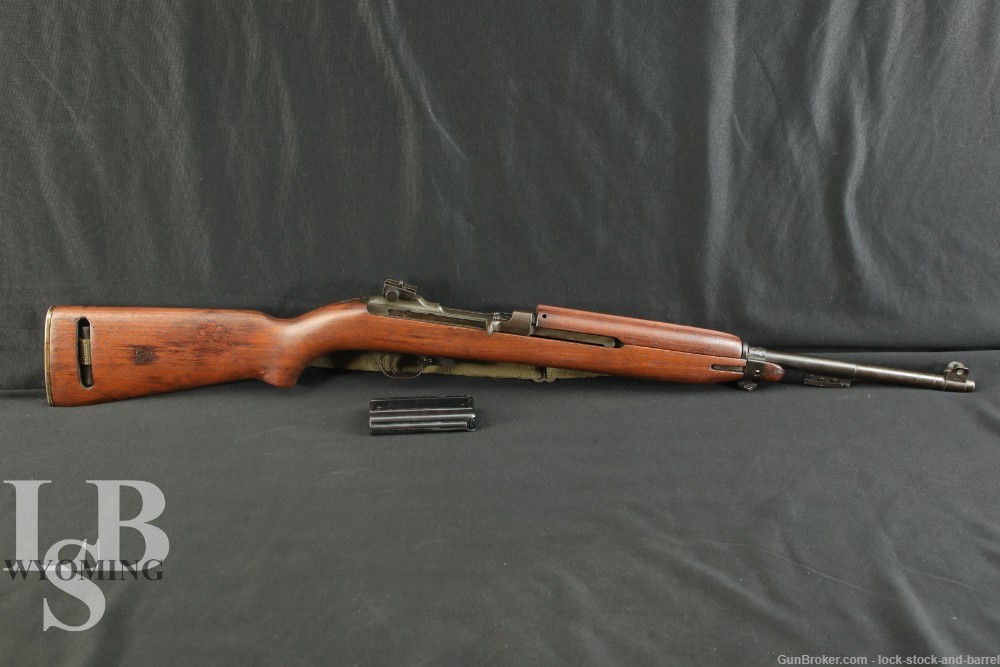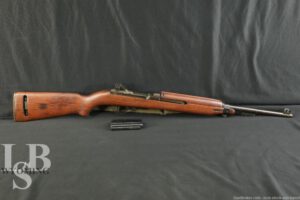
WWII Saginaw Gear Produced Receiver for Inland Div. GM M1 “X” SN Suffix C&R
SOLD FOR: $1,510.00
WOA#: WY240601RN003
Make: Saginaw Gear made receiver for Inland Division of General Motors
Model: M1 Carbine
Serial Number: 944267X
Year of Manufacture: After November 1943
Caliber: .30 Cal Carbine
Action Type: Semi-Automatic carbine fed by detachable magazines.
Markings:
The top of the receiver is marked, “U.S. CARBINE CAL. 30 M1 / INLAND DIV. 944267X”. The X suffix denotes that the serial number has a duplicate serial number made by the Inland Division. So somewhere there is an Inland Division Receiver with the same Serial number just without the X suffix.
The left side of the receiver is marked with “SG” for Saginaw Gear.
The magazine release is marked “M”.
The rear sight is marked “I.R.C.O.” International Register CO.
The Lug is marked “DI”. Standard for Inland Division.
The stock is marked “HI” in the sling cut for Hillerich & Bradsby CO.. The stock also has what appears to be a “T” stamp on the pommel, and Seven overlapping circles burned into the side. The right side has a large ordnance wheel.
The oiler is marked “IS” for International Silver CO. correct for Inland Div.
The right side of the trigger group is marked “N” and the right side with a “9”. This is a National Postal Meter Part.
The left side of the hammer is marked “W” for Winchester.
The slide is unmarked
The Bottom of the barrel is stamped with “5 E BI”, The top of the barrel is marked “P” about 1.5” in front of the gas block and again about mid length, the end of the barrel is marked “INLAND MFG. DIV. / GENERAL MOTORS / 11-43”
The front sight is stamped with “N” for National Postal Meter.
The barrel band is marked “SI”
The upper handguard is unmarked.
Barrel Length: 18″
Sights / Optics: The front sight is a fixed blade set between protective ears. The rear sight is the later style sliding aperture sight with a knurled windage knob dovetailed to the receiver.
Stock Configuration & Condition: The stock is an Oval cut, low wood stock, with a type one two rivet handguard, type three barrel band with bayonet lug, a later style flip type safety and a checkered metal Buttplate. The LOP measures about 13” from the front of the trigger to the back of the buttplate. The wood stock shows minimal scratches and compressions scattered throughout with a small chip from the top of the sling cut. There are no cracks in the wood. The metal butt plate has mostly sharp checkering, has lost its finish and has begun to turn brown with patina. The handguard is pristine for its age with almost no marks or wear. Overall the wood rates in about Excellent condition.
Magazine Quantity & Condition: This carbine includes one “AI” marked 15 round magazine in Very Good condition. “AI” is for AUTOYRE-INLAND, an Inland Magazine.
Type of Finish: Parkerized.
Finish Originality: Original
Bore Condition: The bore is bright with defined rifling. There is no visible erosion. There are lines and marks in the grooves from use. In this writer’s opinion the bore rates 8/10.
Overall Condition: This rifle retains about 90% of its metal finish. The metal surfaces have mostly turned green / brown from patina. The barrel and barrel band have turned brown but show minimal wear. The friction surfaces on the receiver and bolt show very little wear. The trigger guard has some old oil caked up on the surface which should be easy to clean. Overall, this rifle rates in about Excellent condition for C&R.
Mechanics: The action functions correctly. We did not fire this rifle. As with all used firearms, a thorough cleaning may be necessary to meet your maintenance requirements.
Box, Paperwork & Accessories: This carbine includes the magazine and a green canvas sling.
Our Assessment: During the early stages of World War II, the U.S. military recognized the need for a lightweight rifle that would bridge the gap between the heavy and cumbersome M1 Garand rifle and the standard issue sidearm, the M1911 pistol. The goal was to provide troops with a compact and easy-to-handle firearm that offered more firepower than a pistol but was lighter and more maneuverable than a full-size rifle. In 1941, the U.S. Army’s Ordnance Department contracted with various manufacturers, including Winchester and General Motors’ Inland Division, to develop and produce the M1 Carbine. The rifle was designed by a team led by firearms designer David Williams, who drew inspiration from the successful M1 Garand and the short-recoil action of the M1 Thompson submachine gun. The M1 Carbine featured a gas-operated, semi-automatic action and fired a .30 caliber cartridge known as the .30 Carbine. The cartridge, while less powerful than the standard .30-06 ammunition used in the M1 Garand, offered greater capacity and reduced recoil, making it more controllable and well-suited for short to medium-range engagements. The M1 Carbine saw widespread use in World War II, becoming a staple firearm for American troops. It was praised for its reliability, ease of use, and versatility. The rifle was not only issued to U.S. forces but also provided to allied nations through various lend-lease programs. After World War II, the M1 Carbine continued to serve in the Korean War and saw limited use in subsequent conflicts. It also became popular among civilian shooters and collectors due to its historical significance and manageable recoil. Overall, the M1 Carbine played a significant role in U.S. military history, offering a lightweight and reliable firearm that filled a niche between pistols and full-size rifles. Its compact design, firepower, and ease of use made it a favored weapon among soldiers in various roles and contributed to its enduring legacy. This example began its life in Grand Rapids Michigan at the Saginaw Gear factory where the receiver was made. The receiver has a duplicate serial number to an original Inland receiver. When Inland took possession of the receiver to complete the build they added the X suffix to the serial number and then completed the build. This carbine stands as a marker of history demonstrating the commitment and cooperation that companies in America had to the war effort during WW2. Please see our photos and best of luck with your bidding!!!-R.L.

